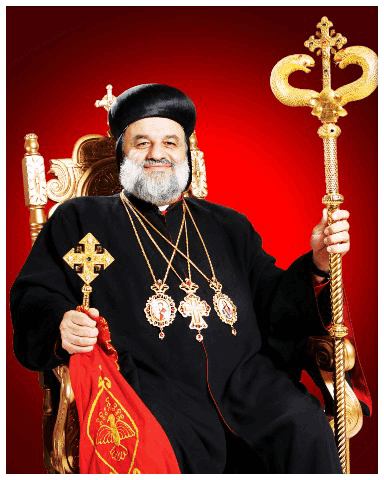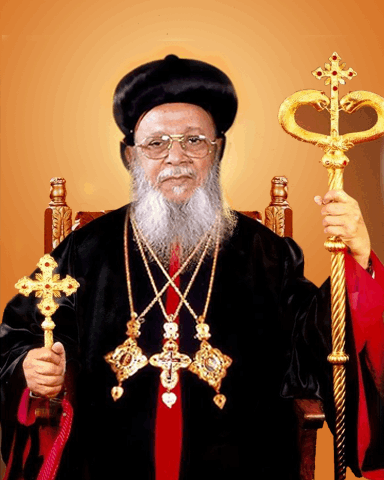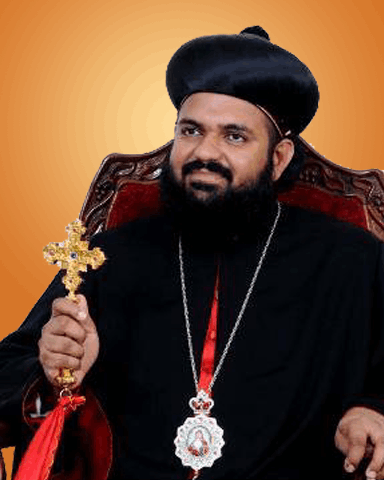History
Throughout Syria and Mesopotamia, Aramaic, in its many dialectical forms, was the language of the land, and Syriac, originally the Aramaic dialect of Edessa in Northern Mesopotamia, must have been the most influential literary form of Aramaic. When we speak of Syriac Christianity, we refer to Christians whose native tongue was Syriac and those who employed Syriac as their liturgical language.
Syriac Christianity was not centered just in Antioch, the Roman capital of Syria. In fact, Syriac Christianity can be traced further East in Mesopotamia. As local tradition tells us, Christianity was received in Edessa during the time of the Apostles. This is reported in a number of documents including Eusebius's Ecclesiastical History. He gives us the text of a correspondence between the city's king, Abgar Ukomo, and none other than Jesus Himself:
Abgar Ukomo, the toparch, to Jesus the good Savior who has appeared in the district of Jerusalem, greetings. I have heard concerning you and your cures, how they are accomplished by you without drugs and herbs ... And when I heard of all these things concerning you I decided that it is one of two things, either that you are God and came down from Heaven to do these things, or are the Son of God for doing these things. For this reason I write to beg you to hasten to me and to heal the suffering which I have ... The reply from Jesus to King Abgar, according to the same tradition, was carried by a certain Ananias and read:
Blessed are you who believed in me, not having seen me ... Now concerning what you wrote to me, to come to you, I must first complete here all for which I was sent, and after thus completing it be taken up to Him who sent me; and when I have been taken up, I will send to you one of my disciples to heal your suffering and give life to you and those with you.
The story continues to describe how one of the Seventy Disciples, named Adai, was sent to King Abgar to heal his disease.
Historical literary sources tell us that by the second half of the second century there was an established church in Edessa, though probably most of the inhabitants remained pagan. The Chronicle of Edessa tells us that in the year 201, a disastrous flood destroyed the church of the Christians in the city. However, it took only about a century until most of the city was under the umbrella of Christianity. Edessa, home of the Syriac form of Aramaic, indeed prides itself as the first kingdom that officially accepted the new faith.
Syriac Christianity has had a long history in India. According to tradition, Christianity in India was established by St. Thomas who arrived in Malankara (Kerala) from Edessa in A.D. 52. The close ties between the Church in Malankara and the Near East go back to at least the fourth century when a certain Joseph of Edessa traveled to India and met Christians there. The church in Malankara today is an integral part of the Syriac Orthodox Church with the Patriarch of Antioch as its supreme spiritual head. The local head of the church in Malankara is the Catholicos of the East, consecrated by and accountable to the Patriarch of Antioch.
Syriac Christianity spread rapidly in the East. The Bible was translated into Syriac to serve as the main source of teaching as early as the second century. Till our day, the antiquity of the Syriac biblical versions is upheld with high esteem by modern scholars. In the words of Dr. Arthur Vööbus, "In our search for the oldest translation of the Greek original [of the New Testament] we must go back to the Syriac idiom" (Studies in the History of the Gospel Text in Syriac, p. 1). The Syriac Church Fathers made no less than six translations and revisions of the New Testament and at least two of the Old Testament. Their scholarship in this domain has no equal in Church history.
The Church of Antioch was thriving under the Byzantine Empire until the fifth century when Christological controversies split the Church. After the Council of Chalcedon in A.D. 451, two camps of the one Church emerged: The Greek Church of Byzantium and the Latin Church of Rome accepted Chalcedon, but the Syriac and Coptic (later Armenian as well) Churches rejected the council. The former group professed that Christ is in two natures, human and divine, whilst the latter adopted the doctrine that Christ has one incarnate nature from two natures. It is worth noting that the drafts of the Council were according to the position of the Syriac and Coptic Churches. The final resolution, however, was according to the doctrine of the Western Churches and was rejected by the Syriac Church. This schism had sad consequences on the Syriac Church during the next few centuries.
As the Emperor supported the Chalcedonian camp, the Syriac Church came under much persecution. Many bishops were sent to exile, most notably Patriarch Mor Severius, who was later given the epithet togho d-suryoye, 'Crown of the Syriacs'. Mor Severius died in exile in 538. By the year 544, the Syriac Church was in an abysmal situation with only three bishops remaining. It was at this time that Mor Yacqub Burd`ono (Jacob Baradeus) emerged to rejuvenate the Church. Mor Yacqub traveled to Constantinople for an audience with Empress Theodora, the daughter of a Syriac Orthodox priest from Mabbug according to Syriac Orthodox sources, and wife of Emperor Justinian. Theodora used her influence to get Jacob ordained as bishop in 544. Later, Mor Yacqub would travel across the entire land reviving the Church. He managed to consecrate 27 bishops and hundreds of priests and deacons. For this, the Syriac Orthodox Church honors this saint on July 30 of every year, the day of his death in 578. A few centuries later, adversaries labeled the Syriac Orthodox Church 'Jacobite' after St. Jacob. The Syriac Orthodox Church rejects this belittling label which wrongly suggests that the Church was founded by Mor Yacqub.
Aside from their ecclesiastical role, Syriac Churchmen have contributed to world civilization. As early as the fourth century, academies and schools were set up in monasteries throughout Syria and Mesopotamia. Monks and scholars where busy studying the sciences of the Greeks, commenting on and adding to them. It is no surprise that when the Arabs, who conquered the Near East at the end of the seventh century, wanted to acquire Greek knowledge, they turned to Syriac scholars and churchmen. Arab caliphs commissioned Syriac scholars to translate the sciences of the Greeks into Arabic. In his film Forgotten Christians, Christopher Wenner describes the impact of Syriac scholars and Churchmen when he describes the school at Deir az-Za'faran monastery, "It was through the monks here that the Arabs received Greek learning, and it was the Arabs of course who passed it back to Europe. Had it not been for the Syriac monks, we in Europe might never have had a renaissance."
The Syriac Orthodox Church survived under the dominion of many empires in the centuries that followed. Under the Arabs, Mongols, Crusades, Mamluks and Ottomans, the Syriac Orthodox Church continued its survival. Neither intimidation nor oppression could suppress the faithful, but the Church diminished in size to a fraction of what it was.
By the beginning of the 20th century, Syriac Orthodox Christianity was confined mostly to mountainous rural areas, such as Tur Abdin, and various towns in the Ottoman Empire. The worst of the persecutions was yet to come. During World War I, massacres and ethnic cleansing befell the Syriac Orthodox Christians at the hands of the Ottoman Turks and the neighboring Kurds. The year 1915 is known in Syriac by sayfo, or '[the year of the] sword'. It is estimated that a quarter of a million perished; villages were emptied; monasteries and Churches were destroyed. This resulted in what the Syriacs call (in Turkish) sefer berlik 'the collective exodus', a migration to the newly established countries of Syria, Lebanon, Iraq and Palestine. Some left the Middle East all-together, forming new communities in the Americas.
As a result of further immigration that ensued, the Syriac Orthodox Church today has faithful not only in the Middle East and India, but in Europe, the Americas and Australia as well.


